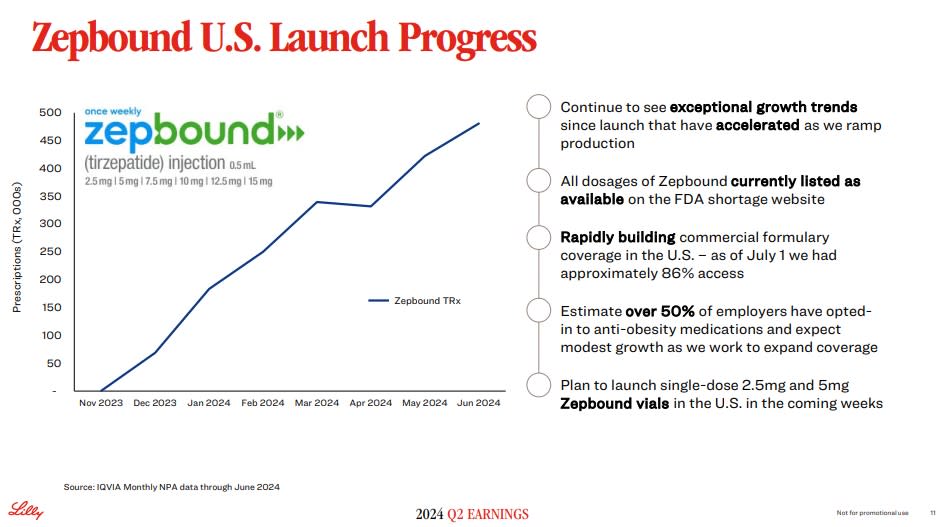Over the last couple of years, the pharmaceutical industry has been taken over by glucagon-like peptide-1 (GLP-1) agonists. Even if you aren't familiar with that terminology, I'd wager that you're well aware of diabetes and obesity medications such as Ozempic, Wegovy, and Mounjaro -- which are all GLP-1 drugs.
For now, Denmark-based Novo Nordisk (NYSE: NVO) dominates the GLP-1 market, thanks to its deep roster of treatments including Ozempic, Wegovy, Rybelsus, and Saxenda. However, Novo Nordisk's chief rival in the weight loss space shouldn't be slept on.
Eli Lilly (NYSE: LLY), the developer of Mounjaro, has proven that it can compete with Novo Nordisk at a high level. Moreover, the company's sibling treatment to Mounjaro -- Zepbound -- has gotten off to a sizzling start since its approval last November to aid weight loss. With more than $1.2 billion in sales in the three months ended in June, Zepbound has already gained the "blockbuster drug" status given to medications selling more than $1 billion in a year.
It's almost enough to make one "forget" about Mounjaro.
Let's break down how Zepbound is helping transform Lilly and assess what the long-term picture could hold.
Zepbound looks unstoppable
Many times, when a new drug receives approval from the Food and Drug Administration (FDA), the approval is granted for treatment of only one condition.
For example, Ozempic is technically only approved to treat diabetes. However, losing weight is often a byproduct of taking diabetes medications. But since Ozempic is not formally approved for chronic weight management, Novo Nordisk released a separate drug called Wegovy aimed specifically at obesity care. It's important to note that Ozempic and Wegovy share the same primary compound, semaglutide.
Eli Lilly has followed a similar template to that of Novo Nordisk. Mounjaro is Lilly's response to Ozempic, and is used in treating diabetes.
Last year was Mounjaro's first full calendar year on the market. The diabetes medication brought in $5.2 billion in annual sales for Lilly in 2023, making it the company's second-largest source of revenue.
While Mounjaro has no doubt been a monumental success, Lilly was also working on something else in the background. As Novo Nordisk did, Lilly developed an alternative version of its diabetes drug -- Zepbound -- which is aimed at treating obesity and also shares its main ingredient, tirzepatide, with Mounjaro.
Zepbound received FDA approval in November 2023 and has been nothing short of a smash since its launch:
During the first quarter of 2024, Zepbound generated $517 million in sales, putting it at an annual run rate of about $2 billion. But according to Lilly's second-quarter earnings report, Zepbound has already demolished its run-rate forecast.
For the quarter ended June 30, Zepbound reported sales of $1.2 billion -- making it a blockbuster drug with less than one year on the market.
The best part? The journey seems to be just getting started.
The ride is just beginning
According to research published by Goldman Sachs, the total addressable market for obesity care medications could reach $100 billion by 2030. Because the World Health Organization (WHO) estimates that more than 1 billion people globally are living with obesity, I'm inclined to think that estimate may be conservative.
Considering the obesity care market is fragmented -- with Novo Nordisk and Eli Lilly being the two major players -- Lilly's growth prospects over the next several years appear robust.
Furthermore, Lilly's management has made some important moves to ensure that supply and demand dynamics don't produce any hiccups. Namely, Lilly acquired a manufacturing facility from Nexus Pharmaceuticals earlier this year to combat any shortages of its weight loss drugs. I think this was a wise decision and positions Lilly well for the future.
Is Eli Lilly stock a buy?
The chart below illustrates Lilly's price-to-earnings (P/E) ratio over the last several years. Clearly, Lilly has experienced quite a bit of valuation expansion, especially over the last 18 months.
While this may suggest that Lilly stock is overvalued, I think there's more to the story. Keep in mind that the S&P 500 is up over 40% since January 2023. Although Lilly has demonstrated consistently impressive financial performance, I think the stock has likely experienced some melt-up activity thanks to broader market conditions.
On top of that, Lilly recently received approval for a new Alzheimer's disease treatment called donanemab, and it's plausible that some of the anticipation about donanemab's approval became priced into the stock.
Despite its pricey valuation, I still see Eli Lilly as an extremely compelling opportunity for long-term investors. Both Mounjaro and Zepbound are already blockbuster drugs. And with an estimated market size of at least $100 billion and little in the way of competition, it's hard to see Lilly experiencing significant downside in the weight loss realm.
As the diabetes and obesity care markets continue to evolve, I think it would behoove investors with a long-term horizon to consider a position in Eli Lilly.
Should you invest $1,000 in Eli Lilly right now?
Before you buy stock in Eli Lilly, consider this:
The Motley Fool Stock Advisor analyst team just identified what they believe are the 10 best stocks for investors to buy now… and Eli Lilly wasn’t one of them. The 10 stocks that made the cut could produce monster returns in the coming years.
Consider when Nvidia made this list on April 15, 2005... if you invested $1,000 at the time of our recommendation, you’d have $763,374!*
Stock Advisor provides investors with an easy-to-follow blueprint for success, including guidance on building a portfolio, regular updates from analysts, and two new stock picks each month. The Stock Advisor service has more than quadrupled the return of S&P 500 since 2002*.
See the 10 stocks »
*Stock Advisor returns as of August 12, 2024
Adam Spatacco has positions in Eli Lilly and Novo Nordisk. The Motley Fool has positions in and recommends Goldman Sachs Group. The Motley Fool recommends Novo Nordisk. The Motley Fool has a disclosure policy.
Forget Mounjaro: Eli Lilly's Next Big Blockbuster Has Arrived was originally published by The Motley Fool

